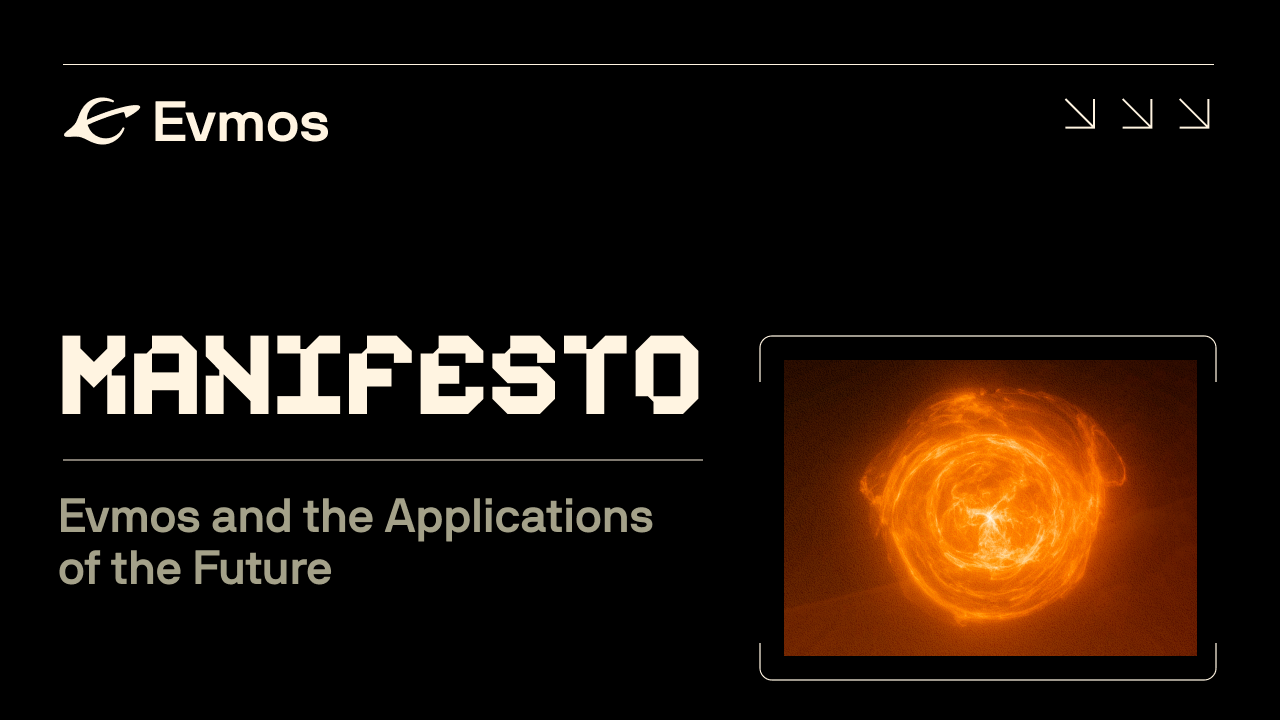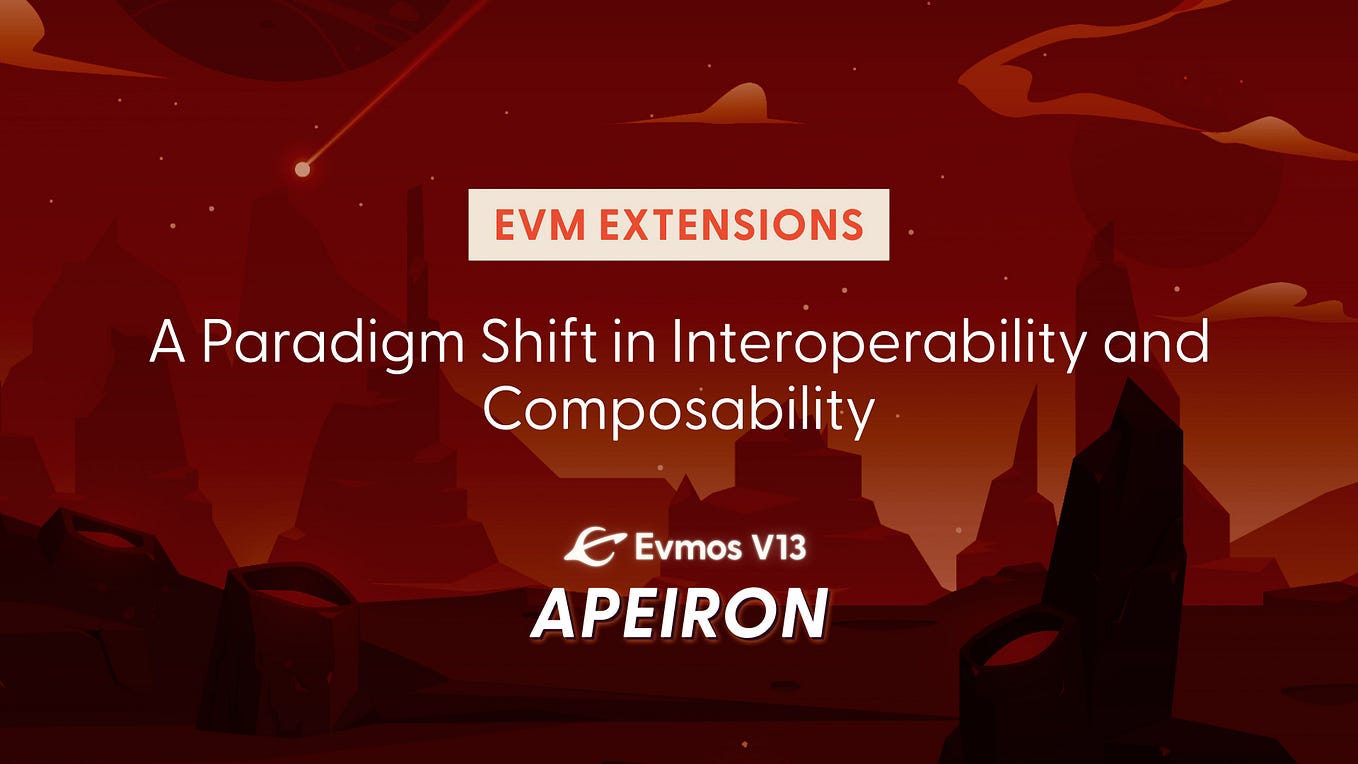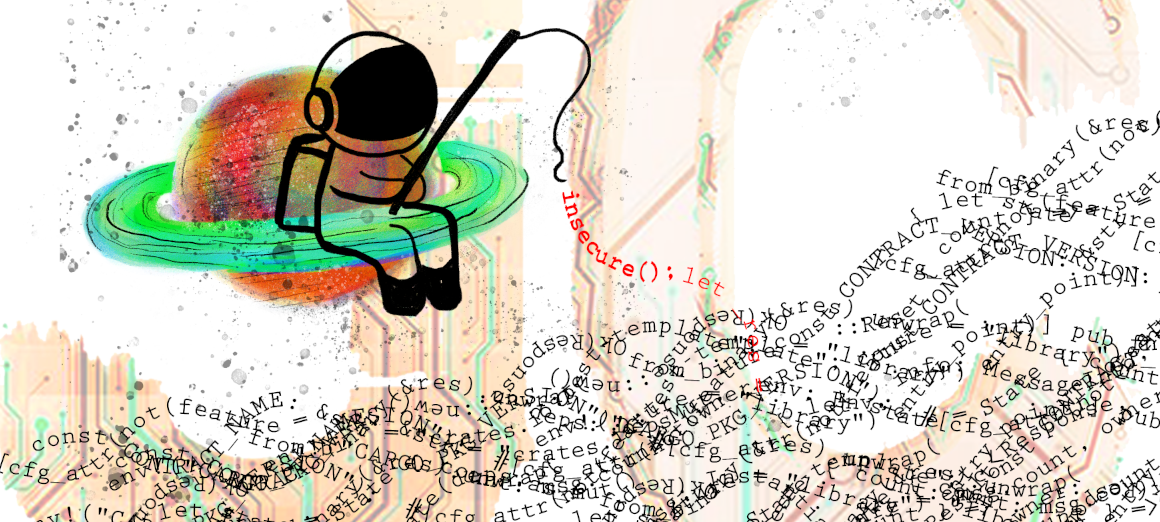The Evmos Manifesto
The Evmos Manifesto
Evmos and the Applications of the Future

 Evmos
Evmos
·
Follow
Published in
The Evmos Blog
13 min read
·
Feb 2, 2023
Listen
Share Evmos started as Ethermint, a community-driven EVM chain built with the Cosmos SDK that would serve as the entry point between the Ethereum and Cosmos ecosystems.
Evmos started as Ethermint, a community-driven EVM chain built with the Cosmos SDK that would serve as the entry point between the Ethereum and Cosmos ecosystems.
In 2021, we noticed Ethermint had stalled without a team fully dedicated to its success. With a determined optimism, we constructed Proposal 44: Ethermint’s Original Text and go-to-market plan, resulting in milestone-based, community funding that came from the Cosmos Hub.
The EVM boasts a rich ecosystem: robust tooling, wallets, explorers, a surplus of assets and intelligent end-users. Cosmos was still nascent and benefited greatly from this existing prosperity if it was shared. It became clear that we, the collective behind Evmos, needed to build an EVM stack on Cosmos that would onramp the existing EVM community while emphasizing the benefits of Cosmos through interoperability of cross-chain technologies.
In 2022, Ethermint became the stepping stone for everything Evmos. Ethermint, as an EVM library for the Cosmos SDK, succeeded in accelerating the introduction of chains, applications, assets and users into Cosmos.The EVM is currently orders of magnitude ahead in terms of developer adoption compared to Cosmos. Last year, we saw these numbers and knew that there was an opportunity to bring EVM developers and the EVM’s rich tooling over to Cosmos.
As of February 1st, 2023, the Evmos network has been running smoothly for 280 days following an explosive re-launch. It blasted through the milestones laid out in the Original Text at record pace for a new L1 blockchain and has witnessed the genesis of many new chains joining the Cosmos Network, in the midst of ground-quaking macro events.
Evmos’ steadfast approach to building has made it a bastion of light in a dark void. Beyond Ethermint’s tech, we built out economic experiments and saw a lot of potential in engaging the community more.
Evmos sought to align three key actors: validators, developers and users. The overall plan was to focus on the underserved by incentivizing developers to build on Evmos while offering users rewards for utilizing applications. In pursuit of the alignment, Evmos introduced the legendary Rektdrop: the first Cosmos and Ethereum joint airdrop as well as the first implementation of a Gasdrop. The goal of the Rektdrop was to give back and incentivize the users who were willing to take the most perilous journeys to the new world. These users offer more value than they are recognized for — they are trailblazers of the most adopted communities that battle-test economic experiments of the future.
Today, smart contract deployers continue to be rewarded by Evmos’ novel Revenue Module, a predecessor to mechanisms like Juno’s fee-sharing mechanism and Canto’s Contract-Secured Revenue. Those pilot efforts have proven significant in incubating an ecosystem of novel applications and tools even in the face of setbacks.
The Evmos Mission
The question is now clear: how will Evmos offer the next millions of builders, users, and communities a stable and bright home?
The Evmos Core Development Team is on a mission to develop and ship the foundational tools necessary for building the cross-chain applications of the future, freeing developers from the confines of today’s siloed blockchains.
Solving Siloed Blockchains: Cross-Chain, Not Multichain
Ethereum applications (dApps) are accustomed to deploying and maintaining multiple instances of the same smart contracts across many chains in a “multi-chain” fashion. dApps do this to obtain aspects of alt-L1 EVMs that aren’t on Ethereum — new liquidity, additional users and greater functionality. However, this increases the overhead of maintaining and upgrading each application and exposes end users to economic fragmentation and bridging risk.
A better way is possible: deploy the application once and use it from any other chain. Adopting a trust-minimized, “cross-chain” approach means applications can avoid being siloed. Every community, asset and feature is potentially within reach, allowing developers to focus on what’s important: building the best application possible for their respective use-case. Developers shouldn’t be limited in reach by their choosing to build on a rollup, an app-chain, or a system of smart contracts on a general L1. Multichain deployments are an anti-pattern. Cross-chain deployments are much more friendly to users and developers.
Multichain deployments are an anti-pattern. Cross-chain deployments are much more friendly to users and developers.
Similarly, users shouldn’t have to care about the blockchain they’re using. They should be afforded the space to choose the platform for getting what they want done as quickly and elegantly as possible, abstracting away the need for them to know what chain the application lives on. No more network switching. It also means a user can pay for, batch, and sign several transactions across several underlying chains and have them all be conditionally executed in a single confirmation.
Users should expect native cross-chain experiences, meaning interactivity is bridgeless by default — no intermediary bridges required and no need to consider bridge risk. Similarly, in Web2, users don’t question whether their browser uses TCP, QUIC, HTTPS, or any other protocol in its transmission of a user’s data across device boundaries. Additionally, users should not be locked into one blockchain platform or the other. Today’s Web2 users do not ask what cloud provider their phone applications run on.
Superseding the de-facto “multi-chain” approach, the “cross-chain” method will disrupt the direction of the industry and the way applications are built for the internet.
The Evmos Core Development Team is building for a world where the next million Web3 users are simply regular users.
There should be no detectable contrast in the quality of UX of today’s centralized applications and tomorrow’s decentralized applications.The internet if developers built cross-chain by default
Cross-Chain by Default with IBC
Evmos is built with cross-chain in mind. It uses a standard called Inter-Blockchain Communication (IBC). The form of cross-chain it uses is trustless because it is based on a light client relay design, meaning it guarantees valid delivery without placing trust in intermediate entities. It’s native meaning it is bridgeless by default — so every chain that implements IBC can talk to each other out of the box — no intermediaries required. As a standardized protocol, it has been adopted by more than 50 chains, including upcoming implementations on Avalanche and NEAR and the list is only growing. All future chains built with IBC will enable them to hook into a growing ecosystem of chains. IBC chains share the burden of secure implementation, meaning ibc-go will always be improving to be the best generalizable cross-chain standard.
The conscious decision to bet on IBC came from watching its development and launch over several years. Osmosis, being the first app-chain in Cosmos, demonstrated that the properties of IBC were extremely well-suited for a cross-chain DEX. However, building an app-chain to the level of Osmosis without a deep understanding of the Cosmos SDK is next to impossible. Evmos will enable EVM dApp developers to leverage IBC directly from the smart contract level — building an entire app-chain is no longer the only means of creating an IBC-enabled application.
The number of IBC-supported blockchains has exploded. It’s gone from just a handful in 2021, to over 50 today, with Evmos being one of them. Third-party solutions such as Axelar, Celer, and LayerZero have championed the benefits of cross-chain UX and can complement the trust-minimized approach of light-client protocols like IBC. This gives Evmos the potential to become the most interconnected blockchain yet.
A New Stack
Many features on Ethereum’s wishlist have already been shipped on Cosmos: Proof-of-Stake (PoS), fast light clients, cross-chain interoperability, and single block finality. Given this common ground, it made sense to analyze their intersection to further understand the possibilities and use that to form Evmos.Ethereum offers the Ethereum Virtual Machine (EVM), an execution environment that leverages permissionless shared state between its applications, giving us programmability and composability by default. The goal of Cosmos is to create an interconnected web of blockchains, each sovereign and controlled by a unique community — but empowered to collaborate with other communities.
The intersection of the EVM with Cosmos SDK modules marries the best of both worlds:
- The permissionless extensibility and developer friendliness of a blockchain through the EVM
- The unmatched developer freedom of Cosmos SDK modules
Synergies will be discovered with applications that connect and enable rich cross-chain interactions. Applications built on one chain will leverage tools, liquidity, and more from other chains. Monolithic architecture will no longer be the norm — applications will be more akin to decentralized microservice architectures. Similar to APIs, this would be enabling applications built in one place to incorporate the functionality of applications built elsewhere, whether they are dApps on other chains or application-specific blockchains.
Evmos aims to be the most feature-rich EVM anywhere by achieving a greater level of composability that wasn’t in the design space of applications prior. There are many applications not suited for Ethereum that may be better suited to deploy on Evmos, which provides wider feature access and customization.
By leveraging IBC, Evmos has the ability to be able to fully interoperate with other execution layers like CosmWasm, Move, or Solana. Smart contracts on Evmos can call functions on contracts in the environments that are running on other IBC chains. Accounts on Evmos can be used to access applications hosted by other chains. This means that Evmos can serve as a secure host for accessing other applications without having to switch networks. Liquidity also takes on new properties when it goes cross-chain — Evmos can aggregate liquidity from many chains, just-in-time to improve capital efficiency and reduce potential slippage. Multiple shallow pools of liquidity can be abstracted and treated as one deep pool, from the user’s perspective.
The goal is to ensure that a seamless cross-chain user experience materializes. An entire set of applications, explorers, wallets, and UIs are waiting to be built, supported by a cross-chain EVM. Evmos pushes forward the evolution of both the EVM and the cross-chain worlds, which are independently flourishing with innovations. Each is enabled by the fact that Evmos is not an alt-L1 blockchain but an entirely new stack at its core, built with robust tech and validated technologies.
Ethermint, Evmos, and a Roadmap to the Future
The Cosmos community paved the way with the modular stack, first described by the Celestia team, and the classic app-chain thesis. The Evmos mission leans heavily on these theses and posits a conclusion from them: the number of blockchains will increase over time, as well as the need for these blockchains to seamlessly and trustlessly communicate with each other. Consequently, the number of Ethermint chains will continue to rise and find success across their respective niches.
Today, we’ve already witnessed and helped support other teams in launching and growing a number of Ethermint chains. Building Ethermint as an open-source library was the right choice. Each of these chains has attracted different sets of decentralized application developers, with some even offering unique features to those builders’ bespoke use-cases. The burgeoning Ethermint ecosystem has been graced by the launches of Cronos, Canto, and Kava and anticipates the planned launches of projects like Argus, Laconic, Berachain, Realio… and the number continues to grow.
The industry is headed toward a world of many application-specific chains, rollups (L2s) alongside their data availability and settlement chains (such as Cevmos), in addition to chains that facilitate the economies of other chains (Ethereum, Polkadot and other hubs) while offering security around them (i.e. shared security). The infrastructure of the decentralized internet will include many blockchains and rollups, and everything in between — effectively providing an infinite supply of differentiated blockspace.
With growth comes increased competition. Blockchains will need to compete by offering builders and users features and experiences they can’t find elsewhere, making the case for viable business models that offer something other chains want. This will also make them complimentary in many cases, with different kinds of applications being built on a variety of chains (sometimes multiple at once), depending on which infrastructure is most suitable.
We believe native cross-chain applications will be the future of internet experiences. The roadmap proposed below is a crystallization of the commitment to the Evmos mission. It breaks down into three key pillars: EVM Extensions, the Evmos SDK, and the dApp Store.Introducing our roadmap for the next few quarters. Our three key pillars — EVM Extensions, the Evmos SDK, and the dApp Store — will define the years to come for Evmos!
EVM Extensions: Stateful Precompiled Contracts on Evmos
The Evmos network is the flagship implementation of the Ethermint library, and the canonical Cosmos EVM. It is the “canary in the coalmine” for new features developed for Ethermint. We are laser-focused on elevating what’s possible for EVMs by enabling Evmos’ smart contracts to cooperate with Cosmos modules. This is done through the use of stateful precompiled smart contracts; a special set of natively-implemented smart contracts that are bundled with an EVM instance at fixed addresses with distinct gas cost logic.
Precompiles are reserved for advanced functionality that would otherwise involve too many opcodes and be too cost-prohibitive to operate. In practice, they are written as a native library as part of the protocol’s client, versus inside of the EVM via Solidity. The EVM’s role is to offer the interface to smart contract developers that runs native code in the background so that existing contracts can leverage the native library. The power of this is that the precompiled code exists outside the boundaries of Solidity and does not execute on the EVM, expanding the space of what’s possible on the implementing chain.
Evmos’ unique implementations of stateful precompiles are called EVM Extensions. For the first time ever, this will allow not only blockchains, but also individual applications to leverage and customize the functionality of IBC and other Cosmos SDK modules. Thus, these extensions push the EVM’s capabilities past its original specification without breaking equivalence with Ethereum’s execution layer.
With the use of EVM Extensions, developers will be able to create their own business logic for connecting with other smart contracts and appchains in the Cosmos ecosystem. Applications will be freed from the confines of a single blockchain and able to make smart contract calls to IBC modules to communicate with other chains, send and receive assets between chains trustlessly, stake EVMOS tokens, and even manage accounts on other blockchains to access any functionality built elsewhere.
Evmos SDK
In 2022, Ethermint’s adoption surpassed expectations, Ethermint is now one of the most actively deployed EVM stacks. Live Ethermint chains boast a collective TVL larger than the rest of the Cosmos ecosystem (Cronos and Canto alone making up the bulk of this).
Geth, Erigon, and other Ethereum clients only go so far in giving developers the agency to construct a technology stack optimally-built for their needs. The Evmos SDK is being built around these constraints and will fill the gap as a tool for developers to construct the platforms necessary for hosting cross-chain applications.
The Evmos SDK is a toolchain to build homes for the applications for the future.
Walking through some case studies:
- Argus is building an EVM platform optimized for on-chain games and requires accessing non-EVM state. The Evmos SDK will provide modular EVM Extensions that offer an interface into the requisite state.
- Canto serves its users with DeFi primitives as public goods, shipping with an AMM and a lending market. The Evmos SDK will allow developers to deploy EVMs with templated smart contracts governed entirely by the protocol itself.
- Cronos created a Proof-of-Authority (vs. PoS) EVM-specific chain that supports DeFi and Gaming applications for Crypto.com users. The Evmos SDK will offer developers the ability to substitute out any part of the blockchain’s stack, including its consensus-related mechanisms.
This SDK will allow blockchain developers to create application-specific chains or EVM chains tailored for specific use cases that are interoperable with other Cosmos and Ethermint chains out of the box! Evmos should not be the only chain to benefit from Ethermint’s innovation. The Evmos SDK democratizes Ethermint and makes it even simpler to build with.
Developers will be able to package extensions like Interchain Token Transfers, Interchain Accounts, and more into these new chains with a simple command line interface (CLI). They can also leverage their own EVM Extensions, implement novel EIPs (e.g. account abstraction, ETH2 light clients, EVM Opcodes), and Cosmos modules. In the future, this customization can extend to replacing peering, consensus, and other base layer functionality if so desired (e.g. Paradigm’s exploration of replacing the Cosmos SDK’s Tendermint consensus engine with Narwhal and Bullshark).
The Evmos SDK enables both greater differentiation and specialization among future chains. Where the Cosmos SDK simplified the creation and deployment of PoS blockchains, the Evmos SDK will make it easier than ever to customize and launch new EVM blockchains.
The Evmos dApp Store
While technology and novel UX are crucial to offer as part of the Evmos value proposition, we’ve also been conscious of distribution — whether it’s helping developers get their applications discovered amongst end-users or our existing token model that is designed to reward activity amongst users, developers and validators.
In line with our philosophy on distribution, we want to empower application builders on Evmos by helping their end users find and explore the many great products being built on Evmos.
That’s why we’ll be launching the Evmos dApp Store this year as the one-stop access point for people to discover and leverage the unique Web3 apps built on Evmos. We’ll be starting with discovery of the broader ecosystem and transitioning our existing applications to fit the mold of the marketplace.
The dApp Store will also highlight apps leveraging functionality over IBC: pushing the envelope for cross-chain applications and shattering the paradigm of siloed application functionality. Users will be able to access a variety of tools and services of interest to the many ecosystems at large and experience everything truly cross-chain native.
Concluding Thoughts
Evmos is not just another L1 or L2. It’s a new EVM stack that puts cross-chain first.
The team is standing at basecamp after a massive Ethermint climb and we’re ready to take Evmos to the next level. We’d like to pay the success forward with a focus on developers with the introduction of EVM Extensions, the Evmos SDK, and the Evmos dApp Store — an EVM stack dedicated to harboring unique apps, while being the most accessible and modular EVM out there.
Some of these plans might change, and that’s expected. There is high conviction in the ones described above.
The Evmos Manifesto is a vision authored by Akash Khosla (@akash_khosla, akash@evmos.org), Nic Z (@nic_xyz, nic@evmos.org), Federico Kunze Küllmer (@fekunze, federico@evmos.org), Hillary Adler (@hillaryadler, hillary@evmos.org), and the Evmos Core Development Team.
Special thanks to those who offered their expert feedback: Frank Spence, Josh Rosenthal, Bobby Beniers, Dmitriy Berenzon, Felix Lutsch, Jon Kol, Jeff Feng, Sunny Aggarwal, Zaki Manian, Jim Chang.
We’d love to hear your feedback on our direction via Twitter, Discord, Telegram, Commonwealth, our DMs or in person if you see us around!
For press outreach please contact Ishan Bhaidani (ishan@scrib3.co)
If you’re interested in working on this mission, check out the current Evmos Jobs listings.
971
7
Crypto
Blockchain
Ethereum
Cosmos
Web3
971
7
 Follow
Follow
Written by Evmos
3.9K Followers
·
Editor for
The Evmos Blog
Enter a world of Ethereum-based applications and assets enhanced by the interoperability of Cosmos.
More from Evmos and The Evmos Blog

 Evmos
Evmos
in
The Evmos Blog
The Evmos Token Model
A model for incentivizing alignment across all actors
11 min read
·
Jan 14, 2022
1K
7
 Evmos
Evmos
in
The Evmos Blog
Reflecting on our Journey: Evmos’ 2023 Year in Review
As we bid farewell to the challenges of 2023 and welcome the promises of 2024, we find ourselves reflecting on a year that tested the…
4 min read
·
Dec 28, 2023
67
1
 Evmos
Evmos
in
The Evmos Blog
The Foundation Delegation Program Cycle 1: Introducing the Validators
We are thrilled to announce the successful completion of the Evmos Foundation Delegation Program Cycle 1 review. After thoroughly…
4 min read
·
Dec 18, 2023
32 Evmos
Evmos
in
The Evmos Blog
The Evmos Rektdrop
This ATOM, OSMO, ETH Airdrop is Better than a Stimulus Check
6 min read
·
Dec 16, 2021
1.93K
15
Recommended from Medium

 Evmos
Evmos
in
The Evmos Blog
EVM Extensions: A Paradigm Shift in Interoperability and Composability
EVM Extensions, a transformative feature of Evmos Apeiron v13, represents a landmark milestone in the fusion of the EVM & Cosmos…
6 min read
·
Jul 14, 2023
19
 Wormhole
Wormhole
in
Interchain Ecosystem Blog
Wormhole Gateway: A New Onramp to the Interchain
Wormhole Gateway: A New Onramp to the Interchain
6 min read
·
Aug 7, 2023
4
Lists


Modern Marketing51 stories
·
356
saves
 My Kind Of Medium (All-Time Faves)58 stories
My Kind Of Medium (All-Time Faves)58 stories
·
177
saves

data science and AI39 stories
·
37
saves
 Generative AI Recommended Reading52 stories
Generative AI Recommended Reading52 stories
·
599
saves Coreum
Coreum
Coreum’s Debut on Osmosis: Bringing Smart Tokens and Connectivity to the XRP Ledger
In the dynamic realm of decentralized finance (DeFi), Osmosis stands out as a decentralized exchange (DEX) pioneering within the Cosmos…
5 min read
·
Dec 1, 2023
3
 Josie Leung
Josie Leung
in
MilkyWay Zone
Introducing Milky Way — liquid staking solution for Celestia
Step into the MilkyWay, a Celestia liquid staking protocol.
6 min read
·
Oct 31, 2023
253
1 Levana Dragon Rider
Levana Dragon Rider
Levana exploit postmortem
Last updated January 4th, 2023 11:25UTC
9 min read
·
Dec 27, 2023
122
4
 JCsec
JCsec
in
Oak Security
CosmWasm security spotlight #3
Are you a CosmWasm Smart Contract developer? A random Cosmonaut peeking into this cool tech? A Solidity auditor looking for new knowledge…
5 min read
·
Oct 9, 2023
80













![[ℕ𝕖𝕧𝕖𝕣] 𝕊𝕖𝕝𝕝 𝕐𝕠𝕦𝕣 𝔹𝕚𝕥𝕔𝕠𝕚𝕟 - And Now What.... Pray To The God Of Hopium?](https://cdn.bulbapp.io/frontend/images/79e7827b-c644-4853-b048-a9601a8a8da7/1)





































